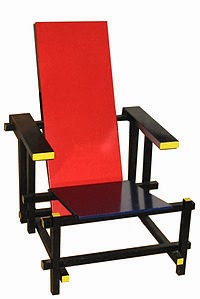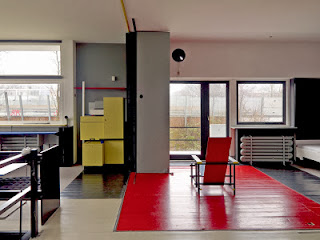The
De Stijl movement’s (originated in 1917) quest was for harmony and order
through a universal language of form in which a particular work can be
understood by all. This movement rejected all representation and was restricted
to the use of straight lines, right angles and pure primary colours (red, blue
and yellow) as well as non-colours (black and white).
De
Stijl got its name from the Dutch magazine’s name edited by Theo Vann Doesburg
in 1917 in which were published works by artists, one of which was Piet
Mondrian. This movement arose at the same time as constructivism and rejected
any imitation to nature. In fact Mondrian formulated his “theory of plasticism” in which he stated that art had to be
completely abstract. Only vertical and horizontal lines can be used.
One
of the most famous works of art for this period is by Piet Mondrian. He makes
use of sever non-figurative designs which reflected the new industrial society.
He only made use of vertical and horizontal lines bringing out rectangular
forms. It is an asymmetrical composition with no representation what so ever.
In fact if this work had to be rotated in any direction it would still make
sense and its meaning would not be altered or lost. For instance;

Other
interpretations are seen in clothing,
Album
covers,
In
3D designs such as the Red and Blue Chair
designed by Gerrit Rietveld in 1917,
 And
later also in buildings such as the schröderhuis in Holland in 1924, which was
an extension of what had started. The cube was the underlying form for
architecture. While the surrounding houses are a block of bricks with dull
colours, this was on the other hand was about bringing the outside to the inside.
This was done by openness which let in more light. Gerrit Rietveld also came up with the idea of
constructing bigger rooms which can be transformed into smaller rooms by making
use of partitions. He also made use of columns inside the house and walls made
of glass, which was completely innovative at the time. In the interior we can
also see experimental work such as the zigzag chair. There is lack of ornament,
a sense of dynamism is created by the use of strong lines and the use of
geometric formal vocabulary.
And
later also in buildings such as the schröderhuis in Holland in 1924, which was
an extension of what had started. The cube was the underlying form for
architecture. While the surrounding houses are a block of bricks with dull
colours, this was on the other hand was about bringing the outside to the inside.
This was done by openness which let in more light. Gerrit Rietveld also came up with the idea of
constructing bigger rooms which can be transformed into smaller rooms by making
use of partitions. He also made use of columns inside the house and walls made
of glass, which was completely innovative at the time. In the interior we can
also see experimental work such as the zigzag chair. There is lack of ornament,
a sense of dynamism is created by the use of strong lines and the use of
geometric formal vocabulary.
Both
found in the house.
All
this was influential to the Modernist Movement. In the meantime in Italy,
Filippo Tommaso Marinetti was founding the Futurist Movement. It was all about
technology and the dynamic aspect of the modern life. It was founded to reject
harmony and order as well as the museum-minded approach to the culture of the
past. Its purpose was to embrace the modern technology namely speed, the
machine and war.
Marinetti
spread the idea that architecture challenges the idea that buildings should
refer to history. Similarly, futurists following that type had to follow
convention so experimented with new forms. For the Futurists, the new type was
a way to emphasise the force of the expressive words. Important artists of this
movement were Umberto Boccioni, Carlo Carra and Giacomo Balla.
Unique Forms of Continuity in Space, 1913 by Umberto Boccioni and François-Raoul Larche
These
two pictures are an example to show the difference between, a Futurist statue
to that of the Art Nouveau movement. It can be clearly seen that the excess of
detail is removed completely, instead of the flowing, soft curves seen in
Larche’s, in Umberto’s statue we get more angular, harsh lines. The delicate
female form is replaced with a bulky almost grotesque figure while the
realistic form is replaced by a more abstract figure.
We
also have Carlo Carrà who
is looking to the Cubist movement and the works of Picasso.
Woman on the Balcony, 1912 in comparison with Pablo Picasso’s Le Guitarist 1910.
We
also have Giacomo Balla, in whose paintings he gives the impression of speed
and fast movement due to the repetition of certain aspects or elements in his
works.
Dynamism
of a Dog on a Leash, 1912.
Charlotte Jirousek. 1995. Art, Design and Visual thinking:
De Stijl. [online] Available at: http://char.txa.cornell.edu/art/decart/destijl/decstijl.htm
[Accessed on 15th November 2013]
Lisa Tatcher. July 2012. Piet Mondrian – Line over Form.[online]
Available at: http://lisathatcher.wordpress.com/2012/07/01/piet-mondrian-line-over-form/
[Accessed on 15th November 2013]
RGC. UN. 107.[online] Available at: http://itsfoolsgold.com/ [Accessed on 15th November 2013]
The White Stripes. June 2000. De Stijl. [online] Available
at: http://www.last.fm/music/The+White+Stripes/De+Stijl
[Accessed on 15th November
2013]
Wickipedia. Red and Blue Chair. [online] Available at: http://en.wikipedia.org/wiki/De_Stijl
[Accessed on 15th November
2013]
Tomáš Petermann. July 2007. Utrecht (Haus Schröder/Rietveld)
[online] Available at: http://www.panoramio.com/photo/3433076
[Accessed on 15th November
2013]
Carlos Zeballos. May 2013. GERRIT RIETVELD: SCHRÖDER HOUSE [online]
Available at: http://architecturalmoleskine.blogspot.com/2013/05/gerrit-rietveld-schroder-house.html
[Accessed on 15th November
2013]
Bar Van der Leck. [online] Available at: https://blogger.googleusercontent.com/img/b/R29vZ2xl/AVvXsEieAtyhnthjLx9kpZTpmKm1pm7lzvJRcayVTXVqQXkb52bfyDrXdBZrRYza0jCK327KT0EjTIch1wE2Ktrejif0YInSRo-qVP43eQLW8yrNIA4u8dr8rnd40_P9MFvCT4fVlTGb7rWnz7c/s1600-h/Bart+van+der+Leck4.aspx
[Accessed on 15th November 2013]
Vallecchi Casa editriche. Vallecchi un sognio lungo un
secolo: Futurismo Manifesto. [online] Available at: http://www.vallecchi.it/portali/37/bs/futurismomanifesto.html
[Accessed on 15th November 2013]
Wikipedia. Picture:
Unique Forms of Continuity in Space, 1913. [online] Available at:
http://en.wikipedia.org/wiki/Umberto_Boccioni
[Accessed on 15th November 2013]
UN. 2013. Macklowe Gallary: François-Raoul Larche [online] Available at: http://www.macklowegallery.com/education.asp/art+nouveau/Artist+Biographies/antiques/Decorative+Artists/education/Fran%26%23231%3Bois-Raoul+Larche+/id/153
[Accessed on 15th November
2013]
Joshsievgallery. UN. Gallery Project. [online] Available at:
http://galleryproject.wiki.hhh.k12.ny.us/joshsievgallery
[Accessed on 15th November
2013]
Art Snapper Beta. May 2013. Giacomo Balla Adopts
the Futurism Style. [online] Available at: http://artsnapper.com/giacomo-balla-adopts-the-futurism-style/#
[Accessed on 15th November
2013]









,_Collezione_R._Jucker,_Milan,_Italy.jpg)


No comments:
Post a Comment